2024 Statewide Audubon Issues
& MWBA Accomplishments
2024 Oregon Audubon Council Issues
Each autumn, Oregon Audubon Council representatives from Audubon Chapters from around the state meet to discuss conservation issues of common concern. Chapters share accomplishments identified from the past year, and align efforts where we can be the most productive for 2024.
Chapters also took time to identify other emerging environmental issues, and shared their approaches to an Audubon name change. Important and intertwined with that are acknowledgements by Chapters of how they have come to be. OAC formally adopted the following statements:
Diversity Makes Us Resilient
As we pursue the critical work of conservation and education, the Oregon Audubon Council is guided by the ideals of equity, inclusion, diversity, dignity, and mutual respect. Recognizing the strength that comes from diversity in both natural systems and human communities, we welcome all people, regardless of race, gender identity, sexual preference, age, disability or citizenship status. We will continually seek to advance and prioritize diversity, equity and inclusion through our programs and partnerships.
Land Acknowledgement Statement
Since time immemorial, Oregon has been home to Native peoples. As the Oregon Audubon Council and its member chapters work to protect wildlife and the environment that surrounds us today, it is right and just to recognize these sovereign Indian Nations and to acknowledge the devastating impacts of colonial settlement. We pledge to learn from Oregon’s tribal nations and look forward to cooperating and collaborating on common goals.
Two Issues are Stand-alone Priorities
We reaffirmed that two issues, equity and climate change should inform all of our priorities rather than serve as stand-alone priorities. All priorities listed below should be viewed through an equity and climate lens:
Forest Protections:
Chapters continue to advocate for greater forest protections at local, state and national levels, and comment on Habitat Conservation Plans for state and private lands, particularly on westside forests. Revisions of the Northwest Forest Plan are being developed at the individual Forest level. Chapters regularly collaborate with other organizations that have additional capacity for this work.
Arid Landscape Wetlands Protections:
The Klamath Basin, Summer Lake, Lake Abert, and Malheur/Harney Lakes basin are critical portions of the Pacific Flyway. Congressional attention reaches Klamath and saline lake ecosystems, yet all of these face increased drought and temperatures exacerbated by climate change, along with water diversions for human use.
Oceans and Coastlines:
Coastal Chapters have taken a strong lead supporting Marine Reserves, Rocky Habitats, Estuaries, and responding to offshore wind energy projects. Critical to their work are sign-ons and advocacy at the state and regional levels.
Imperiled Bird Species and Associated Critical Habitat:
Five species are currently granted levels of protection, and each requires continued attention: Western Snowy Plover continue to need volunteer population monitoring, Northern Spotted Owl need our attention for the programmatic removal of competing Barred Owls, Marbled Murrelets need an update to survey protocols to better identify inhabited forest across their breeding range, Streaked Horned Larks need critical habitat designation across their grassland habitats, and Greater Sage-Grouse need better tracking of conservation efforts, with possible additional protection elements if the species will continue without formal ESA listing status.
Reducing Avian Hazards/Threats:
Individual Chapters continue to work on Bird Collisions, Light Pollution, Cats Safe at Home programs, and Drone use in State Parks, and shared their approaches and support. Along the lines of “certified wildlife habitat,” some Chapters are working to develop a “Bird Friendly Community” certification program to recognize urban communities that commit to improvements across its urban landscape.
Coexistence Strategies:
Beavers and their importance of their habitat have become central to restoration efforts across the state. OAC endorses funding for 1) an ODFW staff position dedicated to education and resolution of human/beaver conflicts and 2) advocacy for administrative prohibition of beaver trapping on federal public lands, such as the Siuslaw National Forest.
Other Issues:
Chapters also support ODFW reform and increased funding, and a stronger conservation voice on the Oregon Wildlife Commission. Many Chapters also work to provide safer and more affordable housing for Oregon’s many unsheltered people, a crisis exacerbated by growing income disparities and the consequences of climate change. Parks and natural areas bear a disproportionate impact when people have little to no other choice.
Diversity, Equity, and Inclusion
The working group completed its work on two recommended documents, which were accepted with some edits. The first is a brief DEI statement for OAC chapters to incorporate into their own statements, and the second is a Land Acknowledgement statement with more significant edits anticipated shortly.
MWBA Accomplishments
Wanted: Not Dead but Alive!
Western Bluebirds
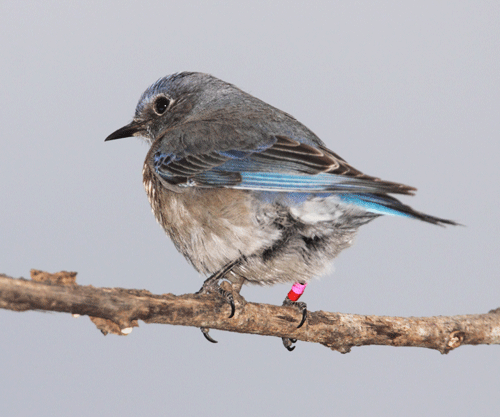
Streaked Horned Larks
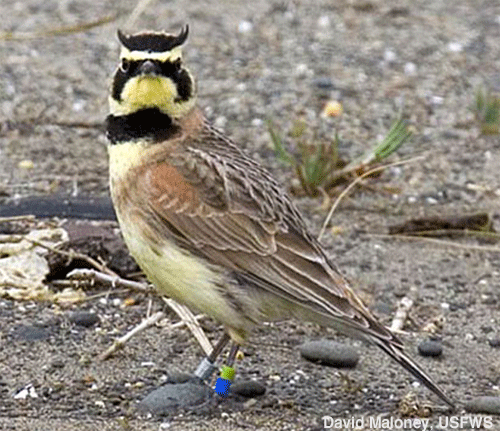
Swifts
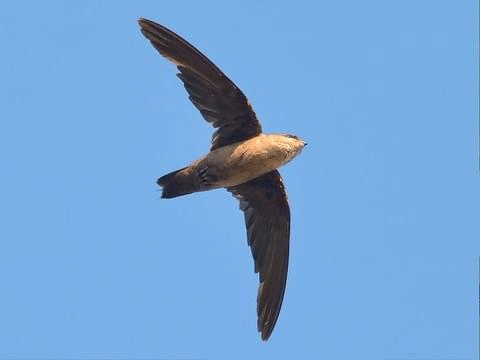
Swifts are the most aerial of birds, spending most of their lives on the wing—foraging for flying insects, skimming water from the surface of ponds, mating in midair, and sometimes even sleeping on the wing. Two species occur regularly in western Oregon, both with specialized requirements for the non-airborne parts of their lives. The larger of the two species, Black Swift (Cypseloides niger), nests on rock cliffs behind waterfalls, and only a few regular nesting locations have been found in Oregon. Black Swift is classed as Endangered with key threats believed to include airborne pollutants that reduce aerial insect availability and climate change that could reduce and/or disrupt the seasonal timing of stream flows at waterfalls.
The smaller species, Vaux’s Swift (the first part of the name rhymes with “boxes”) (Chaetura vauxi) is comparatively well-known due to its tendency to use chimneys as roosting and nesting sites. As with its eastern cousin the Chimney Swift, this is an adaptation to large-scale loss of the old-growth forests where large, dead hollow trees once served this function. Much of the population now depends on man-made structures, especially along their southbound migration route through logged and urbanized areas. (Joel Geier)
Compare swifts and swallow at All About Birds from the Cornell Lab of Ornithology. This handy site compares appearance, life history, maps, and calls.
Contact Swift Coordinator Mary Garrard
Trumpeter Swans
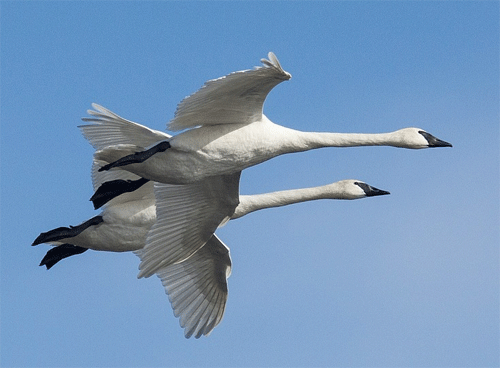
Tundra Swans (Cygnus columbianus) and Trumpeter Swans (Cygnus buccinator) winter in our area. Tundra Swans are smaller, far more common, arrive earlier and stay later, and congregate in huge flocks at mid-valley refuges. Trumpeter Swans are the largest wild bird species by weight in North America, with a wingspan close to that of eagles. In our area, wintering Trumpeter Swans typically arrive in mid- to late November and stay through February.
Historically Trumpeter Swans nested across the continent from Alaska to New England and south to the Rio Grande. Early accounts from Oregon suggest that this species was more abundant than Tundra Swans in the mid-1800s. However the population was decimated by hunting for meat, millinery feathers, and skins almost to extinction until a tiny, nonmigratory population was discovered in the Yellowstone area. In 1968 there were still only 3,700 Trumpeters, and in 2015 the population had climbed to 63,000. Although this is an incredible increase, Trumpeter Swans are still missing from nearly two thirds of their original range. Conservation threats include loss of winter habitat, collisions with utility wires, and lead poisoning. Trumpeter Swans are currently Not Listed on the federal Endangered Species List, and no critical habitat or conservation plans are in effect. For further information see the Trumpeter Swan Society website: www.trumpeterswansociety.org. (from Joel Geier, The Chat December 2018)
Marbled Murrelets

Marbled Murrelets (Brachyramphus marmoratus) are stout seabirds that are related to puffins. Their range is from coastal Alaska to Baja. The species was first described in 1789, but it was not documented until 1974 that they nest high in old-growth trees. The birds are secretive, nest singly – not in colonies, and both parents only fly inland at night to feed chicks.
Most of the year you can find Marbled Murrelets near the coast on quiet bays or occasionally on coastal lakes. They do not form flocks, rather they are in pairs, spending most of the day foraging in shallow water for small fish and crustaceans. When startled, they fly away from the noise with very fast wingbeats.
Since the 1850s, their population has declined 50 – 80% as nesting habitat is logged and fragmented. Marbled murrelets are also threatened by oil spills near their foraging areas. They are listed as Threatened federally and Sensitive in Oregon. Oregon State University’s College of Forestry began a study in 2015 to understand the nesting needs and preferences of Marbled Murrelets. Researchers tag up to 100 breeding murrelets with tiny transmitters every spring, Ultimately the researchers plan to advise forest managers about factors that affect nesting success.
Vesper Sparrows
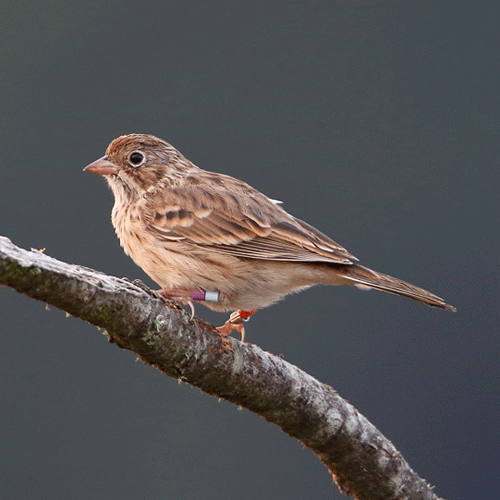
Vesper Sparrows (Pooecetes gramineus) were named because it was thought their melodious song sounded best in the evening. They live in open grassy fields or prairies, foraging for insects and seeds on bare ground around weed clumps. They often dust-bathe on dirt roads or tilled fields. Males defends nesting territory by singing from a perch on a taller plant, while females often mimic an injury to lure an intruder away.
A scientific study is underway to examine two potential factors that may be contributing to Vesper Sparrow population declines: 1) survivorship (Are birds returning after their migrations and wintering?), and 2) recruitment and dispersal (Is there movement of birds between local sites, and if so how far and what are the conditions that facilitate that exchange). Knowledge gained from this effort will help to target how and where to direct conservation actions for recovery.
Greater Sage-Grouse
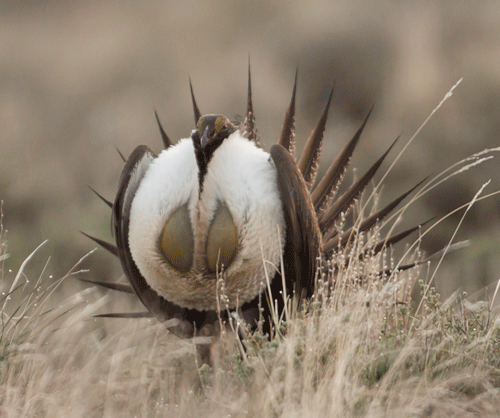
Greater sage-grouse (Centrocercus urophasianus) are the most visible of >350 plant and wildlife species that depend on sagebrush. Their conservation status was determined by the U.S. Fish and Wildlife Service in 2010 to be Warranted for Listing but Precluded by Higher Priorities. Habitat and population fragmentation, coupled with inadequate regulatory mechanisms to control development on public lands, were the primary factors in the listing decision. Approximately 70% of the current sagebrush distribution within the greater sage-grouse range is public land; the U.S. Bureau of Land Management is responsible for managing half of the sagebrush within the United States. Less than 1% of the sagebrush is within areas protected from land-cover conversion. The remaining public land is managed for multiple uses that include livestock grazing, energy development, and recreation.
Managers have emphasized sage-grouse as indicators of ecosystem health. … Therefore, research is focused on gaining a better understanding of how sagebrush and sage-grouse populations are temporally and spatially interconnected. These relationships then can be significant factors in developing conservation actions that enhance the long-term viability of sagebrush ecosystems. (US Geological Survey project)
California Condors
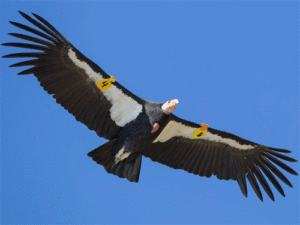
A holdover from prehistoric times, the California Condor (Gymnogyps californianus) is one of our largest and most magnificent birds – and one of the rarest. Soaring over wilderness crags, feeding on carcasses of large dead animals, and reproducing very slowly, condors were not well suited to survival in modern-day southern California. Headed toward extinction in the 1980s, the last birds were brought in from the wild in 1987, to be bred in captivity for eventual release into the wild again. The captive breeding program turned out to be surprisingly successful, and flocks of released condors are surviving in several areas of California and in the region of the Grand Canyon.
Condors roost mornings and evenings and soar on wind currents to forage for carrion during the day. They may find much of their food by watching actions of other scavengers, such as vultures or ravens. Only one egg is laid, and parents trade incubation duties once every 1 – 5 days. Young are capable of flight about 5-6 months after hatching, but may remain dependent on parents for another 6 months. This means that the whole nesting cycle takes more than a year, so condors breed every other year. (National Audubon Society)
Current threats include carcass poisoning and lead ammunition, shooting, and collisions with power lines. California Condors are federally listed as Endangered. Because their range included Oregon, it is a possibility that reintroduction in the state is possible in the future.






